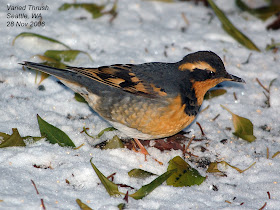Anyone who looks closely at a waxwing usually exclaims
"how smooth it is!" What is there about waxwing feathers that gives
this impression? They really do seem smooth, perhaps in part because the body
is uniformly colored and the individual feathers thus difficult to make out.
Maybe that's all we need to know. Their jaunty crests, black face masks, and
yellow tail tips make waxwings unmistakable birds.
Cedar Waxwings (Bombycilla
cedrorum) are very common in the Pacific Northwest. Small numbers of them
spend the winter, especially in the interior, but many more arrive in spring to
breed throughout our deciduous and mixed woodlands. Because they are confirmed
fruit-eaters, they breed later than many other migrants, so the young when just
off the nest can find plenty of fruit. Many native trees and shrubs flower in
early summer and have mature fruit in late summer, if you didn't know.
Waxwings are really tied to fruit and can survive on a
fruit-only diet longer than other temperate zone songbirds. Males offer berries
to females for courtship feeding, and the young are fed fruit more than is the
case in most of our birds. Of course this diet is augmented with insects, which
are better sources of some nutrients. Waxwings spend much time around water
looking for emerging aquatic insects such as dragonflies, which they often
catch in the air.
You can see waxwings hawking for insects above the treetops
in late summer, but they are still seeking fruit at that time, and any plant
fruiting in September may harbor small flocks of waxwings. In October, most of
them take off for lower latitudes.
The "waxy" tips on wing feathers in waxwings are
merely modifications of the feathers. Imagine the individual feather barbs
becoming thicker and thicker, fusing, and becoming bright red. As a waxwing
matures, it develops more of these tips, and their size and number are a sign
of maturity. Birds with more red tips tend to breed together and breed more
successfully, so more "wax" may be a sign of a bird with higher
fitness.
Bohemian Waxwings (Bombycilla
garrulus), bigger and more colorful, visit the Northwest only in winter
from their breeding grounds in the boreal forest. They are more common on the
east side of the Cascades, where flocks may be encountered in fruiting trees,
many of them non-natives and often in cities and towns.
There is only one additional waxwing, the Japanese species (Bombycilla japonica). It looks much like
the other two but has red tail tips; I wish I had a photo to share, but I've
never seen one.
Dennis Paulson










4.jpg)
















22.jpg)

106.jpg)















.jpg)


